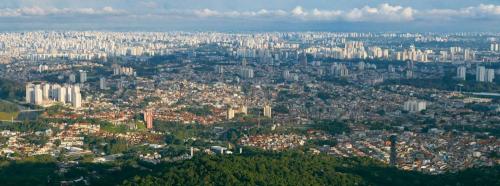
https://www.unesco.org/en/articles/nature-part-us
Nestled a mere 20 minutes from the city centre of São Paulo lies the Mata Atlântica Biosphere Reserve, home to the largest continuous, well-conserved stretch of Atlantic Forest in the world, a sanctuary of rich biodiversity and a testimony to the harmony of humans in nature. At the heart of this coexistence are the Guarani people, the largest indigenous group in the Atlantic Forest biome, who for centuries have been among the most important custodians of these lands.
22 May 2023
Last update: 23 May 2023
Since this area was designated as a biosphere reserve in 1991, UNESCO has collaborated with the Guarani and other indigenous peoples, providing a vital platform to acknowledge and share their knowledge, while contributing to the conservation of the Mata Atlântica ecosystems.
2/4
nextchevron_leftpreviouschevron_right

Guarani indigenous girl
UNESCO/AnnaJuncadella

Mata Atlântica Biosphere Reserve, Brazil
UNESCO/AnnaJuncadella

Guarani indigenous boy
UNESCO/AnnaJuncadella

Mata Atlântica Biosphere Reserve, Brazil
UNESCO/AnnaJuncadella
Conserving biodiversity and respecting Guarani knowledge and culture/way of living
The Guarani people, deeply connected to their ancestral lands, face numerous challenges in safeguarding them. Threats such as illegal logging, expropriation, and urban development continue to encroach on their land. The vastness of this area, as well as the fact that most is covered in dense tropical forest makes monitoring these threats particularly difficult. By designating the Mata Atlântica region as a biosphere reserve in 1991, UNESCO provides a framework to ensure conservation and sustainable use of biodiversity by delineating conservation areas and development plans, amplifying the importance of Guarani knowledge and know-how in addressing challenges and strengthening their actions.
We believe that nature is part of us. It has spirit, it has knowledge, it has life, and we must respect it. People protest in the streets for human rights, but forget to fight for the right to life, and that right to life is the right of all beings.
Karai Djekupe (Thiago), Guarani youth leader
Collaboration for conservation
Lands inhabited and managed by Indigenous peoples, like those inhabited by the Guarani people, overlap with areas of high biodiversity. The close relationship between indigenous cultures and nature serves as a powerful force in conserving biological diversity.
The Mata Atlântica Biosphere Reserve and the Guarani people forge a collaborative partnership rooted in mutual respect and shared goals. UNESCO, local stakeholders, and the Guarani work together in mutual learning to carry out various activities such as restoration projects, sustainable tourism initiatives, keeping native species of bees, and the production of certified products.
2/2
nextchevron_leftpreviouschevron_right

Jekupe Jurandir, Guarani community leader, and his daughter. Mata Atlântica Biosphere Reserve, Brazil
UNESCO/AnnaJuncadella

Jekupe Jurandir, Guarani community leader, Mata Atlântica Biosphere Reserve, Brazil
UNESCO/AnnaJuncadella
We have many challenges in our territory relating to land because our people need land to have a strong culture, to perpetuate our culture. Being part of a UNESCO biosphere reserve helps us to have the power to take care of the Mata Atlântica.
Jekupe Jurandir Augusto Martim, Guarani community leader
UNESCO's support and indigenous contributions
The partnership between the Mata Atlântica Biosphere Reserve and the Guarani people showcases the alignment of UNESCO with indigenous’ worldviews. Solidarity, environmental conservation, collective organization, youth and women's participation, and the dialogue between scientific and indigenous knowledge for biological conservation are key focal points. The biosphere reserve has its own national council, which includes representation from indigenous peoples and local communities , including leaders from the Guarani community. The council serves as a crucial decision-making body, determining plans, priorities, and political issues related to the biosphere reserve.
UNESCO's support extends beyond facilitating frameworks, also providing financial and technical assistance to initiatives such as the Citizen Restoration project (Restauración Ciudadana) of the biosphere reserve. Valuing indigenous economies, knowledge, skills and craftsmanship, UNESCO and the RBMA collaborate so that the initiatives and struggles of the Guarani people can thrive.
Looking to the future
Securing land rights, demarcating territories, and supporting political initiatives that prioritize indigenous communities are crucial steps toward a sustainable future for both the Guarani people and the Mata Atlântica ecosystem. The partnership between biosphere reserves and indigenous peoples exemplifies the power of cooperation, recognizing the invaluable contributions of indigenous communities for living as nature and reconciling conservation of biodiversity with its sustainable use. As we strive to conserve biodiversity and promote its sustainable use, acknowledging and respecting the wisdom and resilience of indigenous cultures is paramount. Together, UNESCO and the Guarani people forge a path toward a future where nature and culture thrive in harmonious coexistence.
More information
UNESCO's commitment to biodiversity
International Day for Biological Diversity
Local and Indigenous Knowledge Systems (LINKS)
SHARE










Add new comment